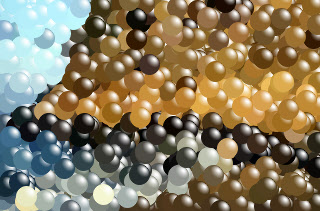L_ColoredBallsBitmap
Summary
This function adds colored balls to the bitmap. Various parameters control the color and appearance of the balls.
Syntax
#include "l_bitmap.h"
L_LTIMGSFX_API L_INT L_ColoredBallsBitmap(pBitmap, uNumBalls, uSize, uSizeVariation, nHighLightAng, crHighLight, crBkgColor, crShadingColor, pBallColors, uNumOfBallColors, uAvrBallClrOpacity, uBallClrOpacityVariation, uRipple, uFlags)
Parameters
pBITMAPHANDLE pBitmap
Pointer to the bitmap handle referencing the bitmap to be changed.
L_UINT uNumBalls
Number of balls that will be drawn in the image.
L_UINT uSize
Average ball size, in pixels.
L_UINT uSizeVariation
Ball size variation. Valid values range from 0 to 100. Use 0 to have all balls the same size. Use 100 to have the size vary from 0 to 2 X uSize.
L_INT nHighLightAng
Light source direction of the highlight color on the ball. This value is in hundredths of degrees (+/-). A positive value will rotate the highlight color clockwise, while a negative value will rotate the highlight color counter-clockwise. Possible values range from 36000 to + 36000.
COLORREF crHighLight
Highlight color.
COLORREF crBkgColor
Background color.
COLORREF crShadingColor
Shade (or gradient) color.
COLORREF *pBallColors
Pointer to an array of ball colors.
L_UINT uNumOfBallColors
The number of ball colors.
L_UINT uAvrBallClrOpacity
Average ball color opacity. Valid values range from 0 to 255 for 8-bit , 0 to 4095 for 12-bit and 0 to 65535 for 16-bit.
L_UINT uBallClrOpacityVariation
Ball color opacity variation. Valid values range from 0 to 100. Use 0 to have all pixels assigned the same opacity. Use 100 to have the opacity vary from 0 to 2 X uAvrBallClrOpacity.
L_UINT uRipple
The number of shades that are used to produce the background. This value is divided internally by 100. For example, if uRipple = 200 the actual frequency is 2. This value is ignored if the CLRBALLS_SHADING_SINGLE flag is set.
L_UINT uFlags
Flags that indicate which background color, shade (or gradient) type, ball type and ball color type to use. You can use a bit wise OR ( | ) to specify one flag from each group. Possible values are:
| Value | Meaning |
|---|---|
| How to draw the shading: | |
| CLRBALLS_SHADING_SINGLE | [0x0001] Use only the background color (i.e. no shading). |
| CLRBALLS_SHADING_LEFTRIGHT | [0x0002] Draw shading as vertical lines that move from left to right. |
| CLRBALLS_SHADING_TOPBOTTOM | [0x0003] Draw shading as horizontal lines that move from top to bottom. |
| CLRBALLS_SHADING_CIRCULAR | [0x0004] Draw shading as concentric circles. |
| CLRBALLS_SHADING_ELLIPTICAL | [0x0005] Draw shading as concentric ellipses. |
| Type of ball to use: | |
| CLRBALLS_STICKER | [0x0010] Use Balls that will overlap like stickers. |
| CLRBALLS_BALL | [0x0020] Use Balls that will adjust like bubbles. |
| How to treat the background: | |
| CLRBALLS_IMAGE | [0x0100] Make the background the same as the image. |
| CLRBALLS_COLOR | [0x0200] Make the background using crBkgColor and crShadingColor with the specified shade type. |
| Type of ball coloring to use: | |
| CLRBALLS_BALLCLR_MASK | [0x1000] Have the Ball color block image colors. |
| CLRBALLS_BALLCLR_OPACITY | [0x2000] Use the opacity value when combining image colors with ball colors. |
Returns
| Value | Meaning |
|---|---|
| SUCCESS | The function was successful. |
| < 1 | An error occurred. Refer to Return Codes. |
Comments
This function does not support signed data images. It returns the error code ERROR_SIGNED_DATA_NOT_SUPPORTED if a signed data image is passed to this function.
The CLRBALLS_STICKER flag produces balls with more distinct edges than the CLRBALLS_BALL option.
To update a status bar or detect a user interrupt during execution of this function, refer to L_SetStatusCallback.
This function supports 12 and 16-bit grayscale and 48 and 64-bit color images. Support for 12 and 16-bit grayscale and 48 and 64-bit color images is available in the Document and Medical Imaging toolkits.
If the bitmap has a region, this function works only on the region. If the bitmap does not have a region, this function works on the entire bitmap.
This function does not support 32-bit grayscale images. It returns the error code ERROR_GRAY32_UNSUPPORTED if a 32-bit grayscale image is passed to this function.
Colored Balls Function - Before

Colored Balls Function - After

View additional platform support for this Colored Balls function.
Required DLLs and Libraries
- LTIMGSFX
- For a listing of the exact DLLs and Libraries needed, based on the toolkit version, refer to Files To Be Included With Your Application.
Platforms
Win32, x64.
See Also
Functions
- L_AddBitmapNoise
- L_EmbossBitmap
- L_MosaicBitmap
- L_MotionBlurBitmap
- L_OilifyBitmap
- L_PosterizeBitmap
- L_RemoveRedeyeBitmap
- L_SolarizeBitmap
- L_UnderlayBitmap
- L_BumpMapBitmap
- L_CubismBitmap
- L_DryBitmap
- L_FreePlaneBendBitmap
- L_FreeRadBendBitmap
- L_GlassEffectBitmap
- L_GlowFilterBitmap
- L_LensFlareBitmap
- L_LightBitmap
- L_OceanBitmap
- L_PlaneBendBitmap
- L_PlaneBitmap
- L_SampleTargetBitmap
- L_TunnelBitmap
- L_BendingBitmap
- L_CylindricalBitmap
- L_FreeHandShearBitmap
- L_FreeHandWaveBitmap
- L_ImpressionistBitmap
- L_PixelateBitmap
- L_PolarBitmap
- L_PunchBitmap
- L_RadialBlurBitmap
- L_RadWaveBitmap
- L_RippleBitmap
- L_SpherizeBitmap
- L_SwirlBitmap
- L_WaveBitmap
- L_WindBitmap
- L_ZoomBlurBitmap
- L_ZoomWaveBitmap
- L_DrawStarBitmap
Topics
Example
The following example loads a bitmap, and applies the colored ball effect:
L_INT ColoredBallsBitmapExample(L_VOID){L_INT nRet;BITMAPHANDLE LeadBitmap;COLORREF pBallColors[7];pBallColors[0] = RGB(230, 50, 50);pBallColors[1] = RGB(230, 200, 160);pBallColors[2] = RGB(255, 255, 128);pBallColors[3] = RGB(240, 50, 100);pBallColors[4] = RGB(255, 255, 180);pBallColors[5] = RGB(170, 240, 100);pBallColors[6] = RGB(255, 255, 255);/* Load the bitmap, keeping the bits per pixel of the file */nRet = L_LoadBitmap(MAKE_IMAGE_PATH(TEXT("cannon.jpg")), &LeadBitmap, sizeof(BITMAPHANDLE), 0, ORDER_BGR, NULL, NULL);if (nRet != SUCCESS)return nRet;/*Apply the effect*/nRet = L_ColoredBallsBitmap(&LeadBitmap, 1000, 25, 15, 31500, RGB(255, 255, 255),RGB(255, 0, 0), RGB(255, 255, 0), pBallColors, 7, 64, 10, 100,CLRBALLS_SHADING_CIRCULAR | CLRBALLS_STICKER |CLRBALLS_IMAGE | CLRBALLS_BALLCLR_OPACITY);if (nRet != SUCCESS)return nRet;nRet = L_SaveBitmap(MAKE_IMAGE_PATH(TEXT("Result.BMP")), &LeadBitmap, FILE_BMP, 24, 0, NULL);if (nRet != SUCCESS)return nRet;//free bitmapif (LeadBitmap.Flags.Allocated)L_FreeBitmap(&LeadBitmap);return SUCCESS;}
© 1991-2023 Apryse Sofware Corp. All Rights Reserved.
